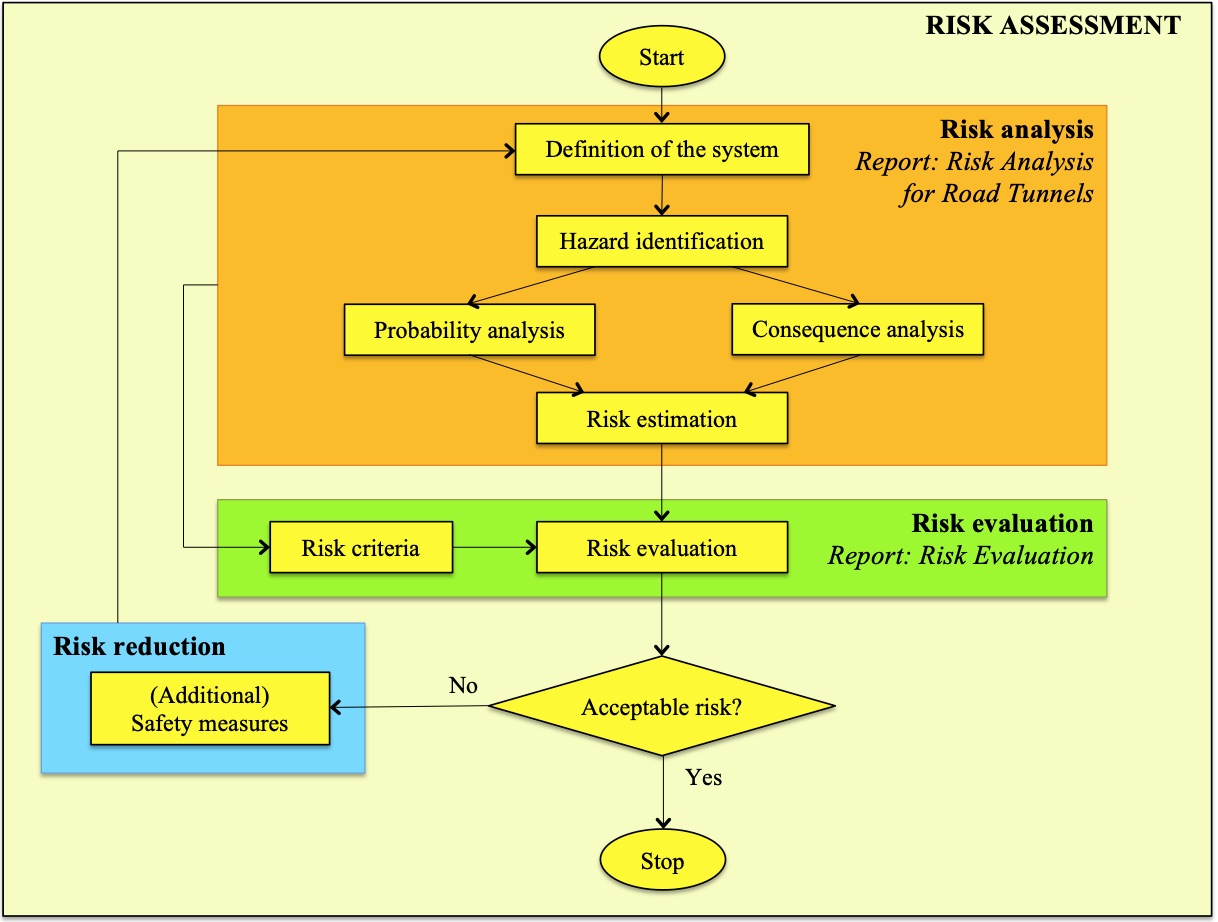Risk assessment
In addition to the traditional prescriptive approach, a risk-based approach - called risk assessment - can be used to address the specific safety features of a tunnel system (including vehicles, users, operation, safety systems, infrastructure conditions, and emergency response) and their impact on safety.
Various types of risk can be addressed in a risk based approach, such as harm to a specific group of people (societal risk), or to an individual person (individual risk), loss of property, damage to the environment or to immaterial values. Commonly, risk analyses for road tunnels focus on the societal risk of tunnel users which can be expressed as the expected number of fatalities per year or as a curve in the FN diagram showing the relationship between frequency and consequences (in terms of number of fatalities) of possible tunnel incidents.
Risk assessment is a systematic approach to analyse sequences and interrelations in potential incidents, thereby identifying weak points in the system and recognising possible improvement measures. Three steps characterise the risk assessment process:
- Risk analysis: Risk analysis is concerned with the fundamental question: "What might happen and what are the probabilities and consequences?". It involves the identification of hazards and the estimation of the probability and consequences of each hazard. Risk analysis can be carried out in a qualitative or in a quantitative way or as a combination of both. Two families of approaches are suitable for road tunnels:
- a scenario-based approach, which analyses a defined set of relevant scenarios, with a separate analysis for each one,
- a system-based approach, which investigates an overall system in an integrated process, including all relevant scenarios influencing the risk of the tunnel, thus producing risk indicators for the whole system.
For system-based risk analyses, quantitative methods are common practice. Thus probabilities of incidents and their consequences for different damage indicators (e.g. in terms of fatalities, injuries, property damage, interruption of services) and the resulting risk are estimated quantitatively, taking due account of the relevant factors of the system and their interaction. - Risk evaluation: Risk evaluation is directed towards the question of acceptability and the explicit discussion of safety criteria. In other words risk evaluation has to give an answer to the question "Is the estimated risk acceptable?" For a systematic risk evaluation safety criteria have to be defined and determination made of whether a given risk level is acceptable or not. Acceptance criteria must be chosen in accordance with the type of risk analysis performed. For instance, scenario-related criteria can be set to evaluate the results of a scenario-based risk analysis, while criteria expressed in terms of individual risk (e.g. probability of death per year for a specific person exposed to a risk) or societal risk (e.g. reference line in a FN diagram) can be applied for a system-based risk analysis. There are different methods of risk evaluation: it can be done by relative comparison, by a cost-effectiveness approach or by applying absolute risk criteria. However, in practice a combination of different approaches is often applied. Important principles for risk evaluation as well as practically applicable risk evaluation strategies are presented in the technical report 2012 R23 “Risk evaluation, current practice for risk evaluation for road tunnels”.
- Planning of safety measures: If the estimated risk is considered as not acceptable, additional safety measures have to be proposed. The effectiveness (and also cost-effectiveness) of the additional measures can be determined by using risk analysis to investigate the impact on the frequency or consequences of different scenarios. Planning of safety has to answer the question "Which measures are best suited to get a safe (and cost-efficient) system?
The simplified flowchart in Figure 1 illustrates the main steps of the risk assessment process

Risk assessment of road tunnels allows a structured, harmonised and transparent assessment of risks for a specific tunnel including the consideration of the relevant influencing factors and their interactions. Risk assessment models provide a much better understanding of risk-related processes than merely experience-based concepts may ever achieve. Moreover, they allow evaluation of the best additional safety measures in terms of risk mitigation and enable a comparison of different alternatives. Hence, the risk assessment approach in the context of tunnel safety management can be an appropriate supplement to the implementation of the prescriptive requirements of standards and guidelines. In practice, there are different methods to approach different kinds of problems. It is recommended to select the best method available for a specific problem.
Although risk models try to be as close to reality as possible and try to implement realistic base data, it is important to consider that the models can never predict real events and that there is a degree of uncertainty and fuzziness in the results. Considering this uncertainty, the results of quantitative risk analysis should be considered accurate only to an order of magnitude and should be supported by sensitivity studies or similar. Risk evaluation by relative comparison (e.g. of an existing state to a reference state of a tunnel) may improve the robustness of conclusions drawn but care should be taken in the definition of the reference tunnel.






